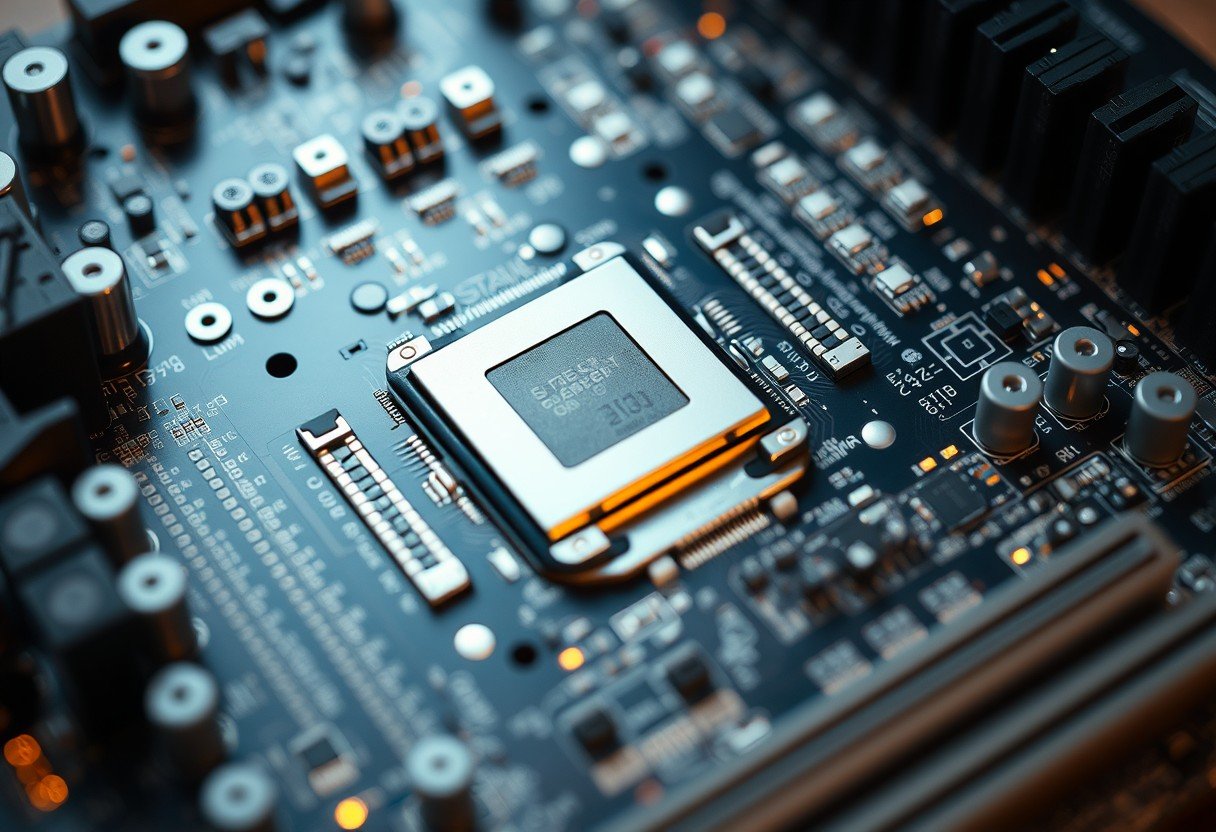If you’ve ever looked into older computer hardware, you may have heard of the Front Side Bus, or FSB. For years, it was the main data highway in a PC. But with the Intel X58 chipset and Nehalem processors, that all changed. The 64-bit FSB was replaced by a new technology called QuickPath Interconnect (QPI). This shift was a huge leap forward, dramatically increasing speed and efficiency and setting the stage for modern computer performance.
Understanding the Old Front Side Bus
Before the X58 chipset arrived, the Front Side Bus was the critical connection linking the central processing unit (CPU) to the main memory (RAM) and other key components. Think of it as a single, multi-lane highway where all the data traffic had to travel.
This design, first introduced in the 1990s, worked well for a long time. It was a simple and effective way for the processor to communicate with the rest of the system. The speed of this bus, measured in megahertz (MHz), was a major factor in a computer’s overall performance.
However, as processors became more powerful and gained multiple cores, this single highway started to get very crowded.
Why the Front Side Bus Became a Bottleneck
The main problem with the FSB was that it was a shared bus. This meant every component connected to it had to take turns using the pathway. As CPUs added more cores, they all had to compete for access to the same limited bandwidth to reach the memory controller.
This competition created a significant performance bottleneck. Data couldn’t move fast enough to keep up with the powerful new processors. The result was increased latency, which is the delay in getting data from the RAM to the CPU. This inefficiency held back the potential of multi-core processors and demanding applications.
It became clear that for computing to advance, the old FSB architecture had to be replaced with something faster and more efficient.
Intel’s Game-Changer: The X58 Chipset and Nehalem
Intel’s answer to the FSB bottleneck came with the release of the Nehalem processor architecture and the accompanying X58 chipset in 2008. This platform marked one of the most significant architectural shifts in a decade.
The Nehalem design fundamentally changed how the CPU communicated with the rest of the system. Instead of relying on a single, shared bus, Intel introduced a new point-to-point connection system. This new approach was designed to give the CPU more direct and faster pathways for data.
Introducing QuickPath Interconnect (QPI)
The star of the new architecture was the QuickPath Interconnect, or QPI. QPI replaced the FSB, creating a direct, high-speed link between the CPU and the chipset. Unlike the shared FSB, QPI provided a dedicated path for data, much like giving a VIP their own private expressway instead of making them use a congested public road.
This point-to-point interconnect offered vastly more bandwidth than the old 64-bit FSB. In systems with multiple processors, QPI also allowed CPUs to communicate directly with each other without having to go through the chipset, which was a massive performance win for servers and high-end workstations.
| Feature | Front Side Bus (FSB) | QuickPath Interconnect (QPI) |
|---|---|---|
| Architecture | Shared Bus | Point-to-Point |
| Communication | CPU to Chipset (Memory Controller) | CPU to Chipset and CPU to CPU |
| Bandwidth | Limited and Shared | Significantly Higher and Dedicated |
| Latency | Higher | Lower |
How QPI Boosted System Performance
The move from FSB to QPI had an immediate and dramatic impact on system performance. By eliminating the central bottleneck, data could flow much more freely and quickly between components.
This new design brought several key benefits that you could feel in everyday use, especially in demanding tasks like gaming, video editing, and scientific computing.
- Increased Bandwidth: QPI offered up to 25.6 GB/s of bandwidth, a massive increase over the fastest FSBs, which topped out around 12.8 GB/s. This allowed multi-core processors to be fed with data much faster.
- Reduced Latency: With a more direct path for data, the delays were significantly cut down. This made the entire system feel more responsive.
- Improved Scalability: The point-to-point nature of QPI made it much easier to build powerful systems with multiple processors, as each CPU had its own high-speed links.
These improvements ensured that the processor could work at its full potential without waiting for data, leading to a smoother and more powerful computing experience.
A Major Shift: Integrating the Memory Controller
Along with the introduction of QPI, the Nehalem architecture made another crucial change. Intel integrated the memory controller directly onto the CPU die. Previously, the memory controller was part of the chipset on the motherboard, and the CPU had to use the FSB to talk to it.
By moving the memory controller onto the processor itself, the path between the CPU cores and the RAM became much shorter and faster. This change worked hand-in-hand with QPI to slash latency and boost memory performance. The CPU no longer had to cross an external bus to access memory, which was a huge step forward for efficiency.
Paving the Way for Modern Processors
The transition from the FSB to QPI was more than just an upgrade; it was a fundamental rethinking of computer architecture. This change laid the groundwork for how all modern high-performance processors are designed today.
The principles of point-to-point interconnects and on-die memory controllers are still at the core of current CPU designs from both Intel and AMD. While QPI itself has since been replaced by the even faster Ultra Path Interconnect (UPI) in Intel’s server chips, its legacy is undeniable. This pivotal shift allowed for the incredible growth in multi-core performance and system efficiency we enjoy today.
Frequently Asked Questions
What technology replaced the Front Side Bus in the X58 chipset?
The 64-bit Front Side Bus (FSB) was replaced by the Intel QuickPath Interconnect (QPI). QPI is a point-to-point interconnect that provides a faster, more direct data path between the CPU and other system components.
What was the main benefit of QPI over FSB?
The primary benefit was a massive increase in bandwidth and a significant reduction in latency. This eliminated the performance bottleneck of the shared FSB, allowing multi-core processors to perform much more efficiently.
Why did Intel move the memory controller to the CPU?
Integrating the memory controller onto the CPU die with the Nehalem architecture shortened the physical distance data had to travel to and from RAM. This move drastically reduced memory latency and improved overall system responsiveness.
Was QPI just a faster version of the FSB?
No, it was a completely different architecture. The FSB was a shared bus where components competed for bandwidth, while QPI was a point-to-point system that provided dedicated, high-speed links, similar to having a private highway instead of a public one.
Is QuickPath Interconnect still used in modern computers?
QPI is no longer used in new consumer or server processors. It has been succeeded by newer interconnect technologies, such as Intel’s Ultra Path Interconnect (UPI) for servers, which build upon the same foundational principles of high-speed, point-to-point connections.









Leave a Comment